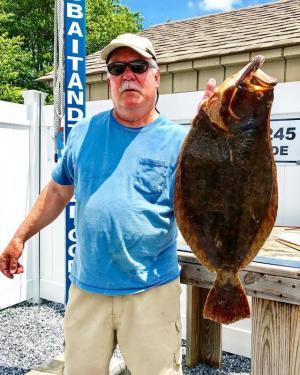Last week, I received a phone call from longtime friend Sunny Crowell. He wanted to tell me about a 10-pound, 10-ounce flounder he caught at Site 10 just outside Indian River Inlet.
First, Sunny caught some spot from Indian River Bay, then headed for Site 10. He fished for three-and-a-half hours, catching one 16.5-inch flounder before missing a good fish twice. He used the GPS function on his electric trolling motor to get back to the same spot, and on the third try, he hooked and landed his prize. To the best of my knowledge, this is the largest flounder caught this year in Delaware.
Sunny and I go back a long way. We grew up together in Claymont and began fishing the local creeks, like White’s, Coon’s and Naaman’s, that were natural flowing in the 1950s, but are nothing more than concrete ditches today.
Then we branched out and started riding our bikes to Beaver Run and the Brandywine Creek in Beaver Valley. I can’t imagine parents today allowing a 10-year-old kid to ride his bike from Claymont down Darley Road to Naamans Road across Concord Pike to Beaver Valley Road and down Beaver Valley Hill, all without a helmet and carrying a fishing rod.
There were a couple of steep hills along the way, and I was not exactly Lance Armstrong when it came to bike riding. Sunny, on the other hand, was able to crest the hills without breaking a sweat and would taunt the fat kid huffing and puffing while pushing his bike uphill.
We would spend most of the day in Beaver Valley catching sunfish, suckers, bass or whatever would bite. Sunny introduced me to artificial lures. He handed me a metal lure shaped like a small fish. I didn’t see how that would catch anything, but on the first cast, I caught a small bass, and from then on, I was a believer.
Sunny moved on to Brown in Wilmington, where he learned the printer trade that served him well. I stayed at Claymont and received an academic diploma that was worthless.
Flesh-eating bacteria
There has been a great deal of press recently about the flesh-eating bacteria found in the Delaware Bay. It is real scary stuff and can be fatal.
Some of the cases have been related to crabs. In these, the person who contracted the bacteria was cut either by the crab pot wire or by the crab. They did not get the bacteria from eating cooked crabs.
All my life, I have been told you don’t eat oysters in any month without an R. That would be May, June, July and August. I still don’t do that, and the bacteria can be in uncooked oysters.
My personal concern is the fact that as a Type 2 diabetic, I have little holes in my hands from blood sugar tests and in my body from four insulin injections a day. You better believe I will be very careful when fishing in Delaware Bay.
Cast for a Cure
I am happy to report that the Cast for a Cure Surf Tournament raised $6,000 for the Tunnell Cancer Center. Tournament Directors Brandy Timmons and Clark Evans presented a check for that amount to Beebe Healthcare. Everyone who took part in this contest can be proud of their accomplishment.
Fishing report
The hot weather and southwest wind kept fishing about the same over the holiday weekend.
The Delaware Bay has been steady, if not spectacular. Kings have been the most consistent catch from the reef sites and the beach. The Angler out of Lewes has been bringing in good numbers of kings plus some trout and blues on every trip. Triggerfish are also on the reef sites along with a few flounder and blowfish.
The slot rockfish season is now open, and a few have been caught out of the Lewes-Rehoboth Canal. The slot is between 20 and 25 inches with a two-fish bag limit, and the Freeman Bridge is the cutoff point for the slot season. I would think some rockfish could be caught at the Outer Wall early in the morning on plugs or bucktails fished close to the rocks.
The Old Grounds are not producing as many flounder as we would hope. Private boats are having a tough time finding any fish, and charter boats are having to work hard to catch the party’s limit.
The inshore lumps such as the Hot Dog, 19-Fathom Lump and Massey’s Canyon saw good bluefin tuna action with big blues and dolphin in the mix. So far, trolling with spreader bars, Joe Shute or Ilander lures with ballyhoo or Green Machines have been the best techniques.

























































